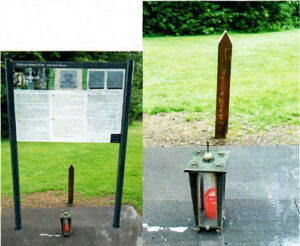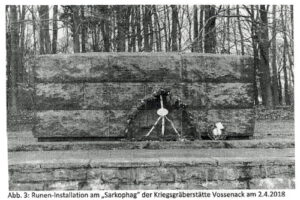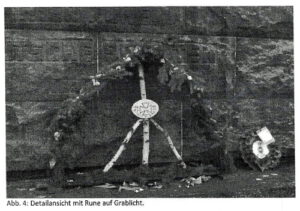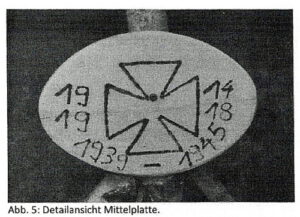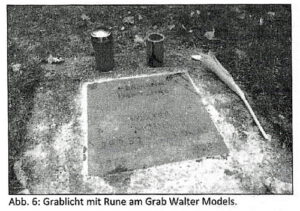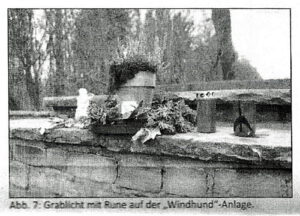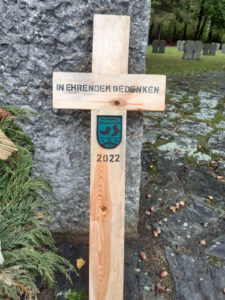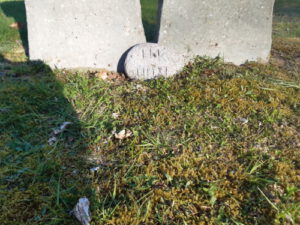“Modern culture of remembrance” in the District of Düren: Information from the District administration on “incidents with a right-wing extremist background” at the military cemeteries in Hürtgen and Vossenack and on “violations” of the cemetery rules (Published on 13/03/2025)
I. The District of Düren “cemetery rules the for the military cemeteries Hürtgen and Vossenack”
As is well known, the District of Düren under District Administrator Wolfgang Spelthahn (CDU) first issued “Cemetery rules for the military cemeteries Hürtgen and Vossenack” (“FO 2008”) in 2008 and tightened them in 2022 (“FO 2022”) to the effect that since then it is prohibited under threat of punishment “in particular”,
“to lay wreaths or flowers, vases or other signs of mourning at the high crosses, the memorial stones or the sarcophagus in Vossenack.”
District Administrator Spelthahn, who was recently suspended by the municipal supervisory authorities in the course of an unprecedented incident on suspicion of serious corruption, expressly insists that a corresponding exemption permit must be applied for from the District of Düren before placing a candle or a flower in the military cemeteries in question. The District of Düren originally stated that its motive for creating cemetery regulations was to “prevent processions and events at the cemeteries of honor (…) that contradict the dignity of the cemeteries as a place of mourning, remembrance and reflection”.
II. The appointment of a “Representative for the care of the Vossenack and Hürtgen war cemeteries as places of a democratic culture of remembrance and commemoration” (“Beauftragter für die Betreuung der Kriegsgräberstätten Vossenack und Hürtgen als Orte einer demokratischen Erinnerungs- und Gedenkkultur”)
Previously, June 15/06/2021, the District of Düren had appointed a so-called “Representative for the care of the Vossenack and Hürtgen war cemeteries as places of a democratic remembrance and commemoration culture”, justifying this, inter alia, as follows:
“The Cemetery Rules are often not respected, especially in Vossenack. Among other things, wreath-laying ceremonies are carried out and symbols and signs with right-wing extremist background are put down. The war grave sites have to be checked regularly, also on the weekends.”
III. The so-called “Violations of the cemetery rules”
Anyone who has ever had closer dealings with the District administration in Düren will be familiar with the fact that the grand speeches often made there usually turn out to be insubstantial on closer inspection. I therefore wanted to know more from the District of Düren about the serious problem of alleged incidents with a right-wing extremist background, about the “frequent violations” of the cemetery regulations and the content of their content.
1. Procedure
From the beginning of 2022, I therefore requested from them repeatedly respective information based on the basis of the Freedom of Information Act of the State of North Rhine-Westphalia (“IFG NRW”). These requests initially related only to the military cemetery in Vossenack, where the alleged problems essentially occurred (“The Cemetery Rules are often not respected, especially in Vossenack”); they were subsequently extended to both cemeteries. The inquiries relating to the cemetery in Vossenack, together with the corresponding information from the District of Düren, have already been presented in this article on the “appointment of a Representative” and are reproduced below for the sake of completeness.
The statutory deadline for responding to requests under the IFG NRW is one month. The District of Düren regularly makes full use of this period or exceeds it, so that a correspondingly broad time frame was necessary.
2. District of Düren: “Incidents with a right-wing extremist background” at the military cemetery in Vossenack from 1952 to 2021
In response to my inquiry about the number of known cases of “wreath-laying ceremonies with a right-wing extremist background” and the “laying of symbols and signs with a right-wing extremist background” at the Vossenack military cemetery, the District of Düren stated that for the entire period from the opening of the military cemetery in Vossenack on 31/08/1952 to 31/12/2015, they were aware of one case of a “wreath-laying ceremony” with an extreme right-wing background and two cases of the “laying of symbols and signs” that were considered to be motivated by extreme right-wing motives (cf. the notice from the District of Düren dated 07/06/2022).
Regarding the content of the wreath-laying ceremony, it was only stated that two wreaths had been laid, one of which had a ribbon with the “analogous” text “Unseren gefallenen Kameraden … Kriegsgräberstiftung”(“To our fallen comrades … War Graves Foundation”). The two alleged cases of “laying symbols and signs with a right-wing extremist background” consisted of two wooden posts, one of which had the inscription “Unseren gefallenen Helden” (“To our fallen heroes”) and the other a swastika and the inscription “Unseren Helden” (“To our heroes”). Remarkably, the signatory of the notice stated that “a conclusive evaluation as regards the right-wing extremist background is not possible to me beyond doubt in all cases” (translation from German language), meaning that he was apparently not fully convinced of the right-wing extremist nature of all the cases reported (cf. the notice from the District of Düren dated 07/06/2022, citations translated from German language).
The District of Düren provided the following photo of the aforementioned violations – only the last-mentioned incident with the wooden pole was photographed, the other two were not (source: District of Düren, photographer unknown):
For the period from 2016 to 2021, the District of Düren stated that it was aware of three cases of corresponding “wreath-laying ceremonies” and one case of the “laying of symbols and signs” that were considered to be motivated by right-wing extremism (cf. the notification from the District of Düren dated 21/02/2022). No comment was made on the content of these wreath-laying ceremonies, only that two of them were carried out by the “Kriegsgräberstiftung Wenn alle Bürger schweigen” (“War Graves Foundation When All Citizens Remain Silent”) and one by the “Kurhessische Marschgruppe Hürtgenwald”.
The one case of the “laying of symbols and signs” consisted of the marking of various objects, e.g. grave candles, with “according to reports” (!) “death runes”, “as they are used exclusively in the extreme right-wing scene”. In response to the additional question as to where this assessment of the “death runes” came from, reference was made to an employee of the “Info- und Bildungsstelle gegen Rechtsextremismus” (“Information and Education Center against Right-Wing Extremism”), which was “part of the NS Documentation Center of the City of Cologne” (cf. the notification of the District of Düren dated 30/03/2022, citations translated from German language).
The District of Düren provided the following black and white photos of the violations between 2016 and 2021 (source: District of Düren, photographer unknown):
3. District of Düren: “Incidents with a right-wing extremist background” at the military cemetery in Hürtgen from 1952 to 2023
In summer of 2023, I also asked the District of Düren for information on how many cases of “wreath-laying ceremonies with a right-wing extremist background” and the “laying of symbols and signs with a right-wing extremist background” on the military cemetery in Hürtgen they are aware of to date – i.e. since the opening of the site 17/08/1952 –, what the content of these cases is and when they became aware of them.
They answered that they were not aware of any such wreath-laying ceremonies at the Hürtgen site.
“Symbols and signs with a right-wing extremist background” were said to have been layed in two cases. In April 2022, a stone with the inscription “MKS MMXI” had been placed near a grave cross. In October 2022, “a wooden cross was placed near a grave cross” on which were inscribed „In ehrendem Gedenken“ (“In honorable memory”) and the “emblem of the Marschgruppe Hürtgenwald 2022“ (cf. the notification of the District of Düren dated 04/08/2023, citations translated from German language).
As I did not and still do not know the meaning of “MKS MMXI”, I asked the District of Düren for further information. Surprisingly, they told me that they did not know the “concrete meaning of the inscription” themselves! The cemetery warden had found an image of the stone on the website of the party “Die Rechte”, “which in the view of the cemetery administration suggested a right-wing connection” (cf. the notification from the District of Düren dated 07/09/2023, citations translated from German language).
The following photos were provided of the appearance of the wooden cross and the stone (source: District of Düren, photographer unknown):
In response to the additional question as to what extent the wooden cross in question contained “symbols and signs with a right-wing extremist background”, the District administration stated that it contained “the inscription ‘Marschgruppe Hürtgenwald’”. The “District of Düren police authority” – which is conveniently headed by the District administrator, i.e. Mr. Spelthahn – had drawn up a corresponding report after the cross was deposited. This fact alone could “at least point to the suspicion that the ‘Marschgruppe Hürtgenwald’ is to be classified as right-wing”. At least in the past, reference was made to reports by Hessischer Rundfunk from 2012, “neo-Nazis were demonstrably to be found in the activities of Marschgruppe Hürtgenwald”; the leader of the marching group was said to be a member of the AfD party (cf. the notification from the District of Düren dated 17/10/2023, citations translated from German language).
The further question of whether, in the opinion of the District administration, even the use of neutral symbols or signs became such with a “right-wing extremist background” if this is done by a group that is suspected of being “right-wing oriented” was not answered. “Further explanations or declarations” of information provided were “not covered” by the IFG NRW (cf. the notification from the District of Düren dated 31/10/2023, citations translated from German language).
4. District of Düren: Violations of the cemetery rules at the military cemeteries in Hürtgen and Vossenack
In view of the District of Düren’s claim that the cemetery rules were “often not observed” at the military cemeteries in Hürtgen and Vossenack, which is why they “have to be checked regularly, also on the weekends”, which was cited as the reason for the need to appoint a corresponding “representative”, I wanted to know from them in September 2023 how many cases of violations of the cemetery rules – the first such rules were enacted on 01/07/2008 – they were aware of in total, what the content of these cases was and when they came to their attention.
To this end, initially only a list of violations of the FO 2022 was submitted (cf. the notification of the District of Düren dated 18/10/2023 and annex); only upon further request was such a list also made available for the FO 2008 (cf. the notification of the District of Düren dated 02/01/2024 and annex). The latter was originally not very informative and was only supplemented upon request (cf. the decision of the district of Düren dated 09/02/2024 and annex).
The content of these lists is remarkable.
a) Violations of the FO 2008
The list of violations of the FO 2008, which covers a period of 12 ½ years, shows a total of 34 “reported incidents against the cemetery rules of 23/06/2008”.
These include six “planned processions”, which raises the question of how a planned, i.e. apparently not carried out, procession can violate the cemetery rules, which only apply to the grounds there, which – since only planned – were reportedly not even entered. So is it possible to violate the cemetery rules without entering the grounds subject to them? In the opinion of the District of Düren, this apparently is the case.
Of the remaining 28 cases, 20 were designated “theft” or “vandalism”, i.e. criminal offenses, whereby more detailed information on the content of the “vandalism” was originally completely missing. However, the term “vandalism” is already an evaluation that cannot be understood without knowledge of the underlying facts. The later selective additions by the District of Düren cast serious doubt on the justification for its assessment of individual incidents as “vandalism”, e.g. with regard to the “theft of a fixing screw” (!) in the room of the Hürtgen permanent exhibition, the dilapidated fixing of the box containing the grave list in Vossenack or the repeated damage to “natural stone walls”, the causes of which are apparently unknown, but which are nevertheless recorded as “vandalism”.
b) Violations of the FO 2022
In the list of violations of the FO 2022, entitled “Incidents at the war cemeteries reported by the cemetery warden”, a total of 41 incidents are specified for a period of only around one year, all of them concerning the placement of grave decorations, mostly grave candles and/or flowers, which the District of Düren only prohibited and made an administrative offense with the FO 2022. In other words: without the prior tightening of FO 2022, not a single one of these activities would be a so-called “incident”!
In 36 of the 41 cases mentioned, grave candles and/or flowers were placed, 26 of which were placed on soldiers’ graves – in contrast to the high crosses, the so-called “sarcophagus” on the site in Vossenack or the various memorial stones. Usually, it will have been family members who decorated the grave of their loved one, especially – as the dates in the list suggest – around Remembrance Day and the Christmas holidays.
IV. Assessment
A closer look at the “incidents with a right-wing extremist background” reported by the District of Düren and the “violations” of the cemetery rules of 2008 and 2022– in addition to a comparatively low frequency, which has only increased recently – reveals the vague nature of a number of these cases, which only become “incidents” as a result of the assessment by the District of Düren. One cannot help but get the impression that they are keen to be able to report as many of these “incidents” as possible and actively promote this through a correspondingly offensive assessment.
For example, it seems to be sufficient there to assume an “incident with a right-wing extremist background” if a group merely suspected of being right-wing extremist places an object with a neutral appearance at one of the two military cemeteries. According to this way of thinking, the placing of a candle or a flower there by such a “suspicious group” is already an “incident with an extreme right-wing background”. The path to Orwellian-style thought crime is not far away here.
The same applies to the alleged cases of “vandalism”. For instance, the theft of a screw is just as much considered the work of vandals as the box with the fastening book on the Vossenack site that came loose from the masonry due to dilapidated fastenings or the damage to a stone wall for unknown reasons.
These very low-threshold assessment standards are also reflected in the number of alleged violations of the cemetery rules. This is most evident in the FO 2022, where 41 “incidents” can be reported for a period of less than a year, compared to “only” 34 for the FO 2008 – in around 12 ½ years! Anyone who does not take a closer look at the background to these figures produced by the District of Düren will see the serious increase in “incidents” claimed by them confirmed. On closer inspection, however, it quickly becomes clear that the District of Düren have artificially produced this increase themselves by declaring every grave decoration deposited without prior approval to be a violation of the cemetery regulations in the FO 2022. Without this serious tightening, there would not be a single one of these 41 “incidents”.
What is the District of Düren trying to achieve?
It has been repeatedly reported on this blog that the District of Düren under District Administrator Spelthahn has committed itself to the fundamental “reorganization” of war commemoration, in the course of which – with the active support of the local press – as many of the commemorative traditions as possible are apparently to disappear. The removal of the memorial board for Julius Erasmus and of the memorial stone for him belong in this context, as does the disgusting “dance theater” over the graves of the war dead in Vossenack on Remembrance Day 2023, always accompanied by conspicuously benevolent and one-sided, but sometimes completely fact-free reporting by the Dürener Zeitung.
For such a fundamental change in the way people think and act, which has been established over generations and is often anchored in religion, it is first necessary to create a need for political intervention. It is possibly tried to convey this to citizens by declaring traditional acts of remembrance on the sites in Hürtgen and Vossenack to be “right-wing extremist incidents” and punishable “violations of the cemetery rules”, which must be avoided, suppressed and eliminated – of course always in the alleged interest of “the dignity of the cemeteries as places of mourning, commemoration of the dead and reflection”. If this is successful and the population is convinced that traditional commemoration should be rejected as “right-wing extremist” and/or “disorderly” and refrained from, the vacuum thus created can be filled with new content as the politicians see fit. This content can then be communicated to the population as “contemporary and correct commemoration”. The ethical and moral garbage that can be expected from this has been more than clearly demonstrated by the aforementioned “dance theater” – initiated by the District of Düren under District Administrator Spelthahn and by the district association of Volksbund deutsche Kriegsgräberfürsorge, whose chairman is conveniently also District Administrator Spelthahn.
However, this was apparently a miscalculation, as evidenced not least by the numerous complaints about the aforementioned “dance theater” to the president of Volksbund deutsche Kriegsgräberfürsorge in Kassel, who even felt compelled to make a public statement (of questionable content). As the latest investigations by the public prosecutor’s office and the unprecedented suspension of District Administrator Spelthahn by the local supervisory authorities show, the “Spelthahn system” is now apparently under increased scrutiny.
Further developments can be looked at with excitement.
(Head picture: German military cemetery Hürtgen, June 2023)
Further articles on the topic “‘Modern culture of remembrance’ in the District of Düren”:
- The removal of the information board on Julius Erasmus from the Vossenack military cemetery in 2021 (03/10/2021)
- Volksbund Deutsche Kriegsgräberfürsorge NRW on the removal of the information board on Julius Erasmus from the Vossenack military cemetery in 2021 (17/06/2022)
- News on the removal of the information board on Julius Erasmus from the Vossenack military cemetery in 2021 (23/08/2022)
- The “representative for the care of the war grave sites Vossenack and Hürtgen as places of a democratic culture of remembrance and commemoration” (“Beauftragter für die Betreuung der Kriegsgräberstätten Vossenack und Hürtgen als Orte einer demokratischen Erinnerungs- und Gedenkkultur”) (16/11/2022)
- The ban on laying flowers and candles at the military cemeteries in Hürtgen and Vossenack (12/02/2023)
- Administrative Court Aachen denies grant of a preliminary order against the District of Düren “flower ban”, appeal to the Higher Administrative Court (23/03/2023)
- Laying of wreaths by the Administrator of the District of Düren at the Military Cemeteries in Hürtgen and Vossenack on Remembrance Day 2022 – or: Quod licet iovi, non licet bovi?(21/04/2023)
- District of Düren denies “flower ban” on Military Cemeteries in Hürtgen Forest to press and media (13/05/2023)
- “Flower ban” of the District of Düren on the Military Cemeteries in Hürtgen Forest: Higher Administrative Court of the State of North Rhine-Westphalia rejects the appeal against the denial of urgent legal protection (03/07/2023)
- Administration out of control – District now also bans photos of the fallen in uniform at Military Cemeteries in Hürtgen Forest (18/08/2023)
- The “permanent exhibition” on the Hürtgen war cemetery (20/12/2023)
- The removal of the memorial stone for Julius Erasmus by the District in September 2022 (06/02/2024)
- The distortion of remembrance on the national Remembrance Day (“Volkstrauertag”) (21/04/2024)
- The “Dance Theater” over the graves of the war dead at the military cemetery in Vossenack on the occasion of Remembrance Day (“Volkstrauertag”) 2023 (19/08/2024)
- The statement of the President of Volksbund Deutsche Kriegsgräberfürsorge e. V. on the “Dance Theater” at the military cemetery in Vossenack on the occasion of Remembrance Day 2023 – a “fact check” (13/11/2024)
If you wish to support my work, you can do so here. Many thanks!


